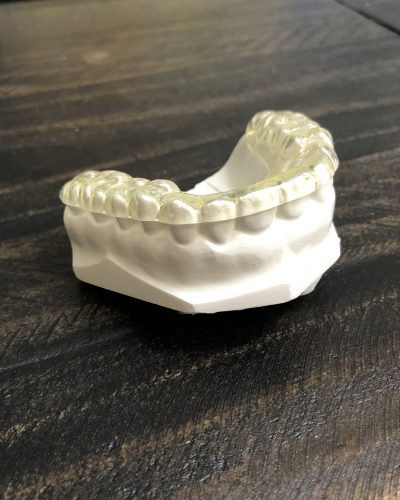Occlusal Guards
Occlusal guards are customized, removable oral appliances that fit over the teeth and are used to prevent damage from harmful pressure and grinding. Occlusal guards are generally designed for one of two purposes: as night guards or as athletic guards.
Night guards are used to prevent damage to the teeth from bruxism, or teeth grinding and clenching while asleep. If not treated with a night guard, bruxism can lead to tooth fracture and damaging wear of the chewing surfaces of your teeth. Unchecked, this destructive process can leave a patient in a situation where many teeth may need to be crowned or even extracted. Bruxism can be a difficult disorder to diagnose since it most commonly occurs while you are unconscious. Common signs you may suffer from bruxism include:
- Tooth pain (especially in the morning)
- Soreness in the jaw
- Headaches
- Audible grinding sounds while sleeping
- Development of cracks in the outer layer of teeth
Night guards are also used to help reduce – and in some cases eliminate – the symptoms of temporomandibular joint disorders, often referred to as TMD or TMJ. Because it does not involve surgery or any drastic changes to the teeth, this is usually the first line of treatment for TMD. The majority of TMD patients experience a reduction or elimination of their symptom from regular use of an occlusal guard. For those who do not experience relief, other treatment options can then be considered.
Athletic guards are used to protect the teeth by cushioning blows to the face during sporting activities. These are highly recommended for collision and contact sports such as boxing, football and rugby, but are advised for some non-contact sports as well, like ice-skating and gymnastics. If you engage in any sport or activity that has a risk of traumatic blows to the face, you should be wearing an athletic guard. They are also strongly recommended for intense weight training. Many people clench down when lifting heavy weights and never realize that they are damaging their teeth.
Athletic guards and night guards are made in similar processes. Once the need for a guard is identified then accurate impressions are taken of the patient’s teeth – both upper and lower arches. These impressions are poured as a stone or plaster cast, which is then sent to a laboratory to fabricate the guard. The patient is brought back once the guard is ready to have it fitted. Minor adjustments are commonly needed to get a proper fit. Additional adjustments may be needed after a few days or weeks of wearing the guard. At Mountain Springs Advanced Dental, these adjustments are included in the price of the guard for a reasonable period after delivery of the appliance.
